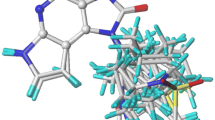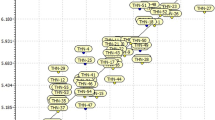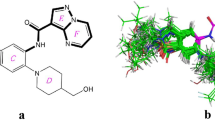Abstract
This study aimed to use a computational approach that combined the classification-based QSAR model, molecular docking, ADME studies, and molecular dynamics (MD) to identify potential inhibitors of Fyn kinase. First, a robust classification model was developed from a dataset of 1,078 compounds with known Fyn kinase inhibitory activity, using the XGBoost algorithm. After that, molecular docking was performed between potential compounds identified from the QSAR model and Fyn kinase to assess their binding strengths and key interactions, followed by MD simulations. ADME studies were additionally conducted to preliminarily evaluate the pharmacokinetics and drug-like characteristics of these compounds. The results showed that our obtained model exhibited good predictive performance with an accuracy of 0.95 on the test set, affirming its reliability in identifying potent Fyn kinase inhibitors. Through the application of this model in conjunction with molecular docking and ADME studies, nine compounds were identified as potential Fyn kinase inhibitors, including 208 (ZINC70708110), 728 (ZINC8792432), 734 (ZINC8792187), 736 (ZINC8792350), 738 (ZINC8792286), 739 (ZINC8792309), 817 (ZINC33901069), 852 (ZINC20759145), and 1227 (ZINC100006936). MD simulations further demonstrated that the four most promising compounds, 728, 734, 736, and 852 exhibited stable binding with Fyn kinase during the simulation process. Additionally, a web-based platform (https://fynkinase.streamlit.app/) has been developed to streamline the screening process. This platform enables users to predict the activity of their substances of interest on Fyn kinase from their SMILES, using our classification-based QSAR model and molecular docking.






Similar content being viewed by others
Data availability
The data in this study is available on our GitHub repository at https://github.com/phuongnvp/fyn_kinase.
References
Marotta G, Basagni F et al (2022) Role of Fyn kinase inhibitors in switching neuroinflammatory pathways. Curr Med Chem 29(27):4738–4755. https://doi.org/10.2174/0929867329666211221153719
Carmela M, Federica P et al (2020) Fyn tyrosine kinase as harmonizing factor in neuronal functions and dysfunctions. Int J Mol Sci 21(12):4444. https://doi.org/10.3390/ijms21124444
Nygaard HB (2018) Targeting Fyn kinase in Alzheimer’s disease. Biol Psychiatry 83(4):369–376. https://doi.org/10.1016/j.biopsych.2017.06.004
Chatzizacharias NA, Kouraklis GP, Theocharis SE (2007) Focal adhesion kinase: a promising target for anticancer therapy. Expert Opin Ther Targets 11(10):1315–1328
Nedunchezhian D, Langeswaran K, Santhoshkumar S (2019) Identification of novel inhibitor targeting Fyn kinase using molecular docking analysis. Bioinformation 15(6):419–424. https://doi.org/10.6026/97320630015419
Gopal D, Muthuraj R et al (2024) Computational discovery of novel FYN kinase inhibitors: a cheminformatics and machine learning-driven approach to targeted cancer and neurodegenerative therapy. Mol Divers. https://doi.org/10.1007/s11030-024-10819-7
Sundarrajan S, Amalraj T, Kumari S, Lulu S, Arumugam M (2014) Screening of bioactive compounds against nonreceptor Fyn kinase: virtual screening and network approach. Int J Comput Biol 3(2):10–17
Mohammeda A, Taghreed M et al (2023) Unveiling phytoconstituents with inhibitory potential against tyrosine-protein kinase Fyn: a comprehensive virtual screening approach targeting Alzheimer’s disease. J Alzheimer’s Dis 96(2):827–844. https://doi.org/10.3233/JAD-230828
Edache EI, Samuel H et al (2020) QSAR and molecular docking analysis of substituted tetraketone and benzyl-benzoate analogs as anti-tyrosine: a novel approach to anti-tyrosine kinase drug design and discovery. Chem Res J 6(5):79–100
Naboulsi I, Aboulmouhajir A, Kouisni L, Bekkaoui F, Yasri A (2018) Combining a QSAR approach and structural analysis to derive an SAR map of Lyn kinase inhibition. Molecules 23(12):3271. https://doi.org/10.3390/molecules23123271
Comelli NC, Ortiz EV, Kolacz M, Toropova AP, Toropov AA, Duchowicz PR, Castro EA (2014) Conformation-independent QSAR on c-Src tyrosine kinase inhibitors. Chemom Intell Lab Syst 134:47–52. https://doi.org/10.1016/j.chemolab.2014.03.003
Ancuceanu R, Tamba B, Stoicescu CS, Dinu M (2019) Use of QSAR global models and molecular docking for develo** new inhibitors of c-src tyrosine kinase. Int J Mol Sci 21(1):19. https://doi.org/10.3390/ijms21010019
Jaeger S, Fulle S, Turk S (2018) Mol2vec: unsupervised machine learning approach with chemical intuition. J Chem Inf Model 58(1):27–35
Shan X et al (2019) Prediction of CYP450 enzyme–substrate selectivity based on the network-based label space division method. J Chem Inf Model 59(11):4577–4586
Davies M et al (2015) ChEMBL web services: streamlining access to drug discovery data and utilities. Nucleic Acids Res 43(W1):W612–W620
Irwin JJ, Shoichet BK (2005) ZINC− a free database of commercially available compounds for virtual screening. J Chem Inf Model 45(1):177–182
Tropsha A, Gramatica P, Gombar VK (2003) The importance of being earnest: validation is the absolute essential for successful application and interpretation of QSPR models. QSAR Comb Sci 22(1):69–77
Gui C, Li Y, Peng T (2023) Development of predictive QSAR models for the substrates/inhibitors of OATP1B1 by deep neural networks. Toxicol Lett 376:20–25
Rose PW et al (2012) The RCSB protein data bank: new resources for research and education. Nucleic Acids Res 41(D1):D475–D482
Trott O, Olson AJ (2010) AutoDock Vina: improving the speed and accuracy of docking with a new scoring function, efficient optimization, and multithreading. J Comput Chem 31(2):455–461. https://doi.org/10.1002/jcc.21334
Roskoski R Jr (2016) Classification of small molecule protein kinase inhibitors based upon the structures of their drug-enzyme complexes. Pharmacol Res 103:26–48. https://doi.org/10.1016/j.phrs.2015.10.021
Kinoshita T, Matsubara M et al (2006) Structure of human Fyn kinase domain complexed with Staurosporine. Biochem Biophys Res Commun 346(3):840–844. https://doi.org/10.1016/j.bbrc.2006.05.212
Jelić D, Verbanac D, Koštrun S, Brandt W (2014) Fyn tyrosine kinase-3-D structure and active site determination. In: 7th MipTec, Basel, Switzerland, pp 3–6
Poli G, Tuccinardi T, Rizzolio F, Caligiuri I, Botta L, Granchi C, Ortore G, Minutolo F, Schenone S, Martinelli A (2013) Identification of new Fyn kinase inhibitors using a FLAP-based approach. J Chem Inf Model 53(10):2538–2547. https://doi.org/10.1021/ci4002553
Daina A, Michielin O, Zoete V (2017) SwissADME: a free web tool to evaluate pharmacokinetics, drug-likeness and medicinal chemistry friendliness of small molecules. Sci Rep 7(1):42717
Phillips JC et al (2020) Scalable molecular dynamics on CPU and GPU architectures with NAMD. J Chem Phys 153(4):44130. https://doi.org/10.1063/5.0014475
Lee J et al (2016) CHARMM-GUI input generator for NAMD, GROMACS, AMBER, OpenMM, and CHARMM/OpenMM simulations using the CHARMM36 additive force field. J Chem Theory Comput 12(1):405–413. https://doi.org/10.1021/acs.jctc.5b00935
Tropsha A, Golbraikh A (2007) Predictive QSAR modeling workflow, model applicability domains, and virtual screening. Curr Pharm Des 13(34):3494–3504
Long S, Ji S, Xue P, **e H, Ma Y, Zhu S (1971) Network pharmacology and molecular docking on the molecular mechanism of Shiliao decoction in the treatment of cancer malnutrition. Front Nutr. https://doi.org/10.3389/fnut.2022.985991
Khan SA, Lee TKW (2022) Network pharmacology and molecular docking-based investigations of Kochiae Fructus’s active phytomolecules molecular targets, and pathways in treating COVID-19. Front Microbiol. https://doi.org/10.3389/fmicb.2022.972576
Silva IRD, Parise MR, Pereira M, Silva RAD (2021) Prospecting for new catechol-O-methyltransferase (COMT) inhibitors as a potential treatment for Parkinson’s disease: a study by molecular dynamics and structure-based virtual screening. J Biomol Struct Dyn 39(16):5872–5891. https://doi.org/10.1080/07391102.2020.1794963
Dowden H, Munro J (2019) Trends in clinical success rates and therapeutic focus. Nat Rev Drug Discov 18(7):495–496
Harrison RK (2016) Phase II and phase III failures: 2013–2015. Nat Rev Drug Discov 15(12):817–818
Funding
This research did not receive dedicated funding from any specific grant provided by public, commercial, or not-for-profit sectors.
Author information
Authors and Affiliations
Contributions
Nguyen Thu Hang: Conceptualization, Methodology, Writing—Review & Editing; Thai Doan Hoang Anh: Formal analysis, Investigation, Writing—Original Draft, Writing—Review & Editing; Le Nguyen Thanh: Software, Writing—Review & Editing; Nguyen Viet Anh: Software, Writing—Review & Editing; Nguyen Van Phuong: Conceptualization, Methodology, Writing—Original Draft, Writing—Review & Editing.
Corresponding author
Ethics declarations
Conflict of interest
No potential conflict of interest was reported by the authors.
Additional information
Publisher's Note
Springer Nature remains neutral with regard to jurisdictional claims in published maps and institutional affiliations.
Supplementary Information
Below is the link to the electronic supplementary material.
Rights and permissions
Springer Nature or its licensor (e.g. a society or other partner) holds exclusive rights to this article under a publishing agreement with the author(s) or other rightsholder(s); author self-archiving of the accepted manuscript version of this article is solely governed by the terms of such publishing agreement and applicable law.
About this article
Cite this article
Hang, N.T., Anh, T.D.H., Thanh, L.N. et al. In silico screening of Fyn kinase inhibitors using classification-based QSAR model, molecular docking, molecular dynamics and ADME study. Mol Divers (2024). https://doi.org/10.1007/s11030-024-10905-w
Received:
Accepted:
Published:
DOI: https://doi.org/10.1007/s11030-024-10905-w




